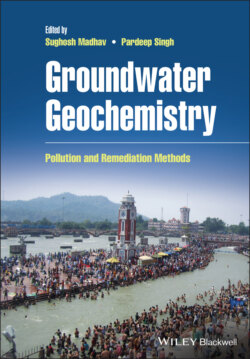Читать книгу Groundwater Geochemistry - Группа авторов - Страница 123
4.6.4 Membrane Filtration
ОглавлениеThis technique shows great potential for decontamination of heavy metals for their high efficiency and easy operation (Hao et al. 2018; Khulbe and Matsuura 2018). The membrane process has been explored with various types of techniques like microfiltration (MF), ultrafiltration (UF), reverse osmosis (RO), and electrodialysis. In the UF technique, a low‐pressure driven membrane process including pore size (10–10 000 Å) is used for the removal of dissolved and colloidal materials. High removal efficiency of metal ions could be achieved by using micellar‐enhanced ultrafiltration (MEUF) and polymer‐enhanced ultrafiltration (PEUF). The micelles containing membrane are having smaller pore size than a UF retaining contaminants, where the untapped species readily pass through the UF membrane. An anionic surfactant, sodium do‐decyl sulphate (SDS), is often selected for the effective elimination of toxic metal ions in MEUF. PEUF uses a water‐soluble polymer to complex metallic ions and form a macromolecule which will be retained, when pumped through UF membrane. Thereafter, the retained material can be recycled in order to recover metallic ions and to reuse the polymeric agent. In PEUF, the main complexing agents like polyacrylic acid (PAA) (Labanda et al. 2009) and polyethylene imine (PEI) (Aroua et al. 2007) used to achieve selective separation and recovery of heavy metals with low energy requirements.
The electrodialysis (ED) process carries out the separation of ions across charged membranes from one solution to another solution following an electric field as the driving force. Mostly, ion‐exchange membranes (cationic and anionic) are used in ED processes. It has been widely used for the production of drinking water, process water from brackish water and seawater, treatment of industrial effluents, recovery of useful materials from effluents, salt production, and for heavy metal wastewater treatment.
According to the literature, the RO (reverse osmosis) process is a very old and famous method thought of as the best method to remove arsenic from water. The RO membrane has extremely small pores (<0.001 μm). The RO membrane process can achieve a high rejection of low molecular mass compound and ions. The cellulose acetate RO membrane was been investigated for the first time in the 1980s, and has a 90% As removal efficiency with the RO system with 400 psi high pressure. However, Akin et al. have investigated the RO operational parameters. A semi‐permeable membrane is used, which allows the fluid that is being purified to pass through it, while rejecting the contaminants. It accounts for more than 20% of the world's desalination capacity (Shahalam et al. 2002). RO is an alternative option for wastewater treatment in chemical and environmental engineering. The major problem with RO is the high power consumption due to the pumping pressures, and the restoration of the membranes.
